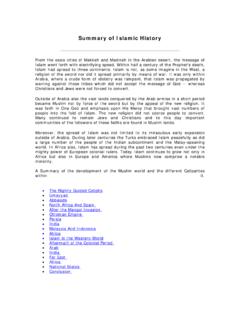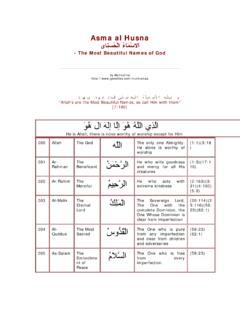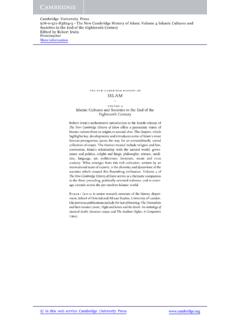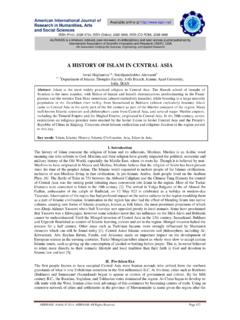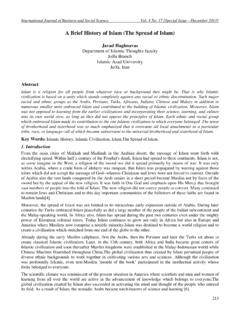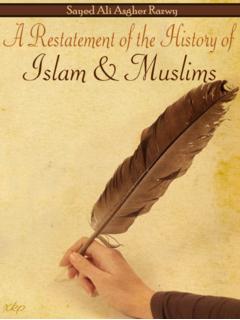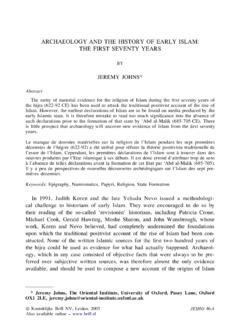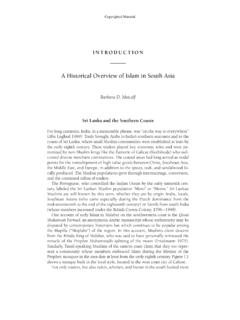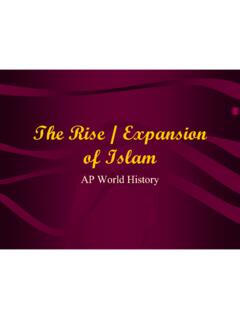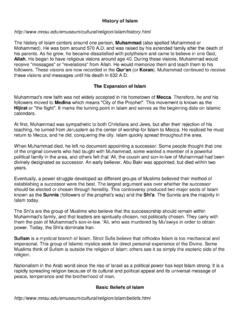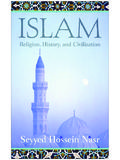Transcription of Milestones in the history of Islam in Eritrea
1 Milestones in the history of Islam in Eritrea Ismael Mukhtar Note: this paper is based on a lecture delivered by the author in the Eritrean Muslim Council s 6th annual convention held in Washington in July 2008. The history of Islam in Eritrea can be traced back to the early days of the emergence of Islam in Arabia. Eritrea s proximity to Mecca made it a natural early recipient of the message of Islam . Islam has shaped Eritrean culture, history , social norms in a very profound way. Islam has deep roots in Eritrea . Its history there evolved over several centuries with various Milestones and pivotal historic moments. This article explores the history for Islam in Eritrea by examining five selected Milestones that contributed profoundly to shaping Islam in Eritrea . Migration of the companions of Prophet Mohamed (PBU) from Mecca to Abyssinia The companions of Prophet Mohammed (PBU) migrated to Abyssinia to escape the cruel persecution of the Meccan pagans.
2 They chose Abyssinia upon the recommendation of the Prophet (PBU), who described the king of Abyssinia as a king under whose domain no one will be wronged . He further described the land of Abyssinia as the land of truth .1 The migration of the companions took place in two waves. The first wave took place in the fifth year of revelation. The group of migrants consisted of 11 men and 4 women. Prominent among them were Ruqaya, daughter of the Prophet (PBU), and her husband Uthman Ibn Afan. This group remained in Abyssinia for a very brief period. The second wave consisted of about 83 men and 18 women. Included in this group was Jaffar Ibn Abi Talib, cousin of the Prophet (PBU). Another group of 50 Muslims from Yemen also migrated to Abyssinia at a later time. This group of Muslims left Yemen aiming to meet the prophet in Medina, but the sea waves forced their ship towards the Western coast of the Red Sea.
3 Hence, they decided to join the already existing community of Muslim migrants in Abyssinia. The Muslim migrants remained in Abyssinia until the 8th year AH (628 AD). The total number of years spent by these immigrants in Abyssinia is estimated to be 13 years. Their total number, including children, is estimated to be in the hundreds. Some would put the estimate in the range of The king of Abyssinia, commonly referred to in Arabic as Negashi (Negus in English), welcomed the companions and extended his full protection to them, refusing Meccan requests to extradite them. Although historical details are meager and many existing narrations have varying degrees of authenticity, all Islamic sources from books of hadith to books of history ascertain the occurrence of this migration to Abyssinia. Further, they report that upon the death of Negashi, the prophet announced to Muslims in Medina his demise and performed for the funeral prayer for him in The Historian Ibn Kathir notes that the prophet corresponded with two 1 Ibn Kathir, Albidaya wa Nihaya, volume 2 (Arabic) 2 Gaith Fathi, Al- Islam Wal Habasha (Arabic) 3 Bukhari, Book of Funerals.
4 Kings in Abyssinia: the King who received the companions (and who accepted Islam ) and his successor, whom the prophet invited to The route taken by these immigrants and the exact location where they settled can not be established with certainty. The late Mufti of Eritrea , Sheikh Ibrahim Al-Mukhtar, asserts that the companions landed first in Badi (Massawa).He quotes a narration reported by the historian Ibn A saker in which Uthman Ibn Afan, makes reference to Badi as his landing point after Further, Fathi Gaith notes that based on the description given by the historian Ibn Hisham, the location of the companions was close to the Blue Nile in the center of the highlands where the capital of the Negashi was found6. Moreover, it is a well known fact that the historical capital of Abyssinia was Axum, in the province of Tigray. Currently, a mausoleum believed to contain the remains of Negashi exists in Tigray, close to the border of Eritrea .
5 This mausoleum is mentioned in the annals of Faqih Arab AlJizani who accompanied Imam Ahmed (Gragn) in the 16th Accordingly, it is possible to conclude that these companions landed in Massawa and marched towards the King s capital through Eritrea . It is difficult to establish what kind of impact this immigration left behind. But it is certain that it was the first contact between Islam and Abyssinia. This migration has left a lasting positive legacy for Abyssinia in Islamic history . Islamic sources confirm Negashi s secret conversion to Islam . Considering the number of years the companions spent in Abyssinia, the size of their community and the support and sympathy they received from the King, it is plausible that other Abyssinians might have accepted Islam as well. Conquest of Egypt and the Islands of Dahlak Egypt was conquered during the reign of the Caliph Omar Ibn Al-Khattab in the year 20 AH (640 AD).
6 Similarly, the Eritrean Dahalk Islands were conquered in 84 AH (702 AD) during the Umayyad Caliphate. Dahalk Islands were safe heavens for pirates for a long time. The pirates threatened the movements of ships in the Red Sea and the coastal cities and towns. Successive Umayyad rulers tried to reign in these pirates by sending successive expeditions to punish them, with no avail. As a final measure, the Umayyad took over Dahlak and established rule and order in the region. The conquest of Egypt was important in facilitating the movement of Muslim and Arab merchants and preachers to the Nubian Kingdom in Sudan and the Beja tribes residing in Eastern Sudan and Eritrea . Similarly, the conquest of Dahalk pacified the Red Sea and resulted in an increase in migration, trade and commercial activities. Rivalries in the Hijaz region in Arabia between the Hashimites and Umayyads and later between the Abbasids and Alawites contributed to a further increase in migration from Hijaz to East Africa.
7 Some of the failed anti Umayyad revolts that took place in Hijaz contributed to 4 Ibn Kathir, Albidaya wa Nihaya, volume 2 5 Sheikh Ibrahim Al-Mukhtar, Al-Wahda newsletter, 1965 ( ) 6 Gaith Fathi, Al- Islam Wal Habasha (Arabic) 7 Al-Jizani Faqih Arab, Futuh al habasha (Arabic) migration of prominent families from Hijaz to Eritrea and else where. Many Eritrean Muslim tribes still trace their ancestry to Hijazi migrants until this day. While these claims are difficult to establish, they aggregately point to a wide ranging Hijazi migration to the region. Sabe notes that subsequent to the conquest of Dahalak the Umayyads built fortresses and posts to ensure safety of the trade routes. This in turn encouraged larger settlements in the region. Further, he notes that the three centuries following the 7th century were periods of intermarriage between the migrant Arabs and local Bejas and other Kushite tribes.
8 Moreover, he notes that through intermarriage and commerce Islam spread in the Hence, the conquest of Egypt and Dahalak were pivotal moments that facilitated the spread of Islam and the establishment of Muslim communities in Eritrea . Emergence of Imam Ahmed Al-Ghazi (1506-1543) and the growth of Ottoman influence Imam Ahmed Ibrahim (commonly known as Gragn left handed-) emerged as the strong man of the Kingdom of Adal following years of unrest and internal turmoil. As soon as he solidified his control over the kingdom, he braced himself for a confrontation with the Christian king of the highlands by refusing to pay the annual tribute imposed on his kingdom. This led to a series of battles that lasted for fifteen years in which the Imam conquered the highlands, took control of the capital of his rival and reached the borders of Sudan. King Lebna Dengel s efforts to stop the Imam failed miserably.
9 Upon the advice of his mother, he asked for help from Portugal. Imam Ahmed in turn sought the help of the Ottomans. Despite his initial success, Imam Ahmed ultimately lost and was killed in battle, probably by a shot from a Portuguese King Galawdewos, son of Lebna Dengel, regained control over the highlands again. The initial successes of Imam Ahmed and the subsequent landing of the Portuguese had far reaching consequences. Islam spread rapidly during this period and the rivalry between the Ottomans and the Portuguese over control of the area intensified. The final outcome of this rivalry was the successful take over of the city of Massaw by the Ottomans. With the Ottoman conquest, the cities of Massawa and Hirgigo rose in prominence. They became the seat of the powerful Naeb family10 that ruled the area for three centuries. The Naeb rulers were nominally deputies of the Ottoman governor in Hijaz, but were practically autonomous.
10 During the Naeb rule Massawa became the center of Islamic civilization and learning in Eritrea . Numerous mosques, various educational and civic institutions and courts were established. Hence, Massaw became the focal center of Islamic civilization and repository of Islamic architecture and historical monuments. Unfortunately, this wealth of history and architecture was largely destroyed during the wars of liberation. Further, the war displaced its inhabitants who embodied its distinctive culture, history and collective memory. Emergence of Sufi orders and its wide spread influence 8 Sabe Uthman, Tareekh Aritrea (Arabic), 1977. 9 Pankhurst Richard, The Ethiopians, Blackwell Publishers, 1998. 10 Dante Oudrisi, Al-Musta mara AL-Aritrea (Arabic translation), 1911 The different Sufi orders emerging in the surrounding Muslim world made a presence in Eritrea through various teachers and preachers.
